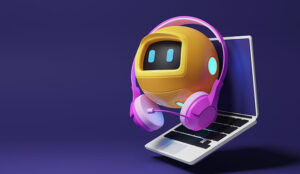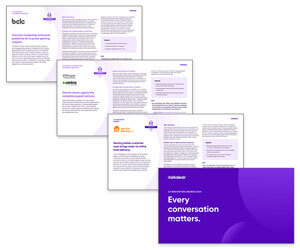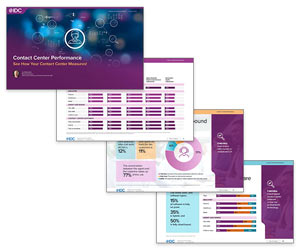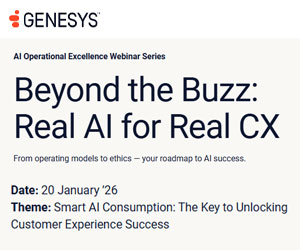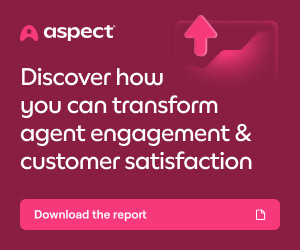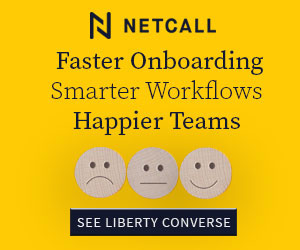Toussaint Celestin at Talkdesk breaks down what AI agents are, how they work, and why they’re becoming essential for businesses looking to scale efficiently. Plus, he explores the real benefits, from cutting response times to enhancing customer experience, and share practical tips for getting started.
AI agents are like digital problem-solvers-intelligent, adaptable, and capable of handling tasks without constant human oversight. They analyze data, make decisions, and take action, from troubleshooting issues to optimizing workflows.
With businesses under increasing pressure to deliver faster, more personalized experiences, AI agents are stepping in to bridge the gap, freeing up human agents for more complex, high-value interactions.
As 81% of customers now prefer self-service options before reaching out to a human agent, organizations are turning to AI agents to meet these expectations while improving efficiency.
Beyond customer service, AI agents address a growing workplace challenge: 68% of employees say they lack enough uninterrupted focus time during the workday. By handling repetitive tasks and automating workflows, AI agents free employees to focus on strategic work.
According to Microsoft’s Work Trend Index, 49% of people express concerns about AI replacing jobs, but an even greater percentage-70%-would delegate as much work as possible to AI to lighten their workload.
What is An AI Agent?
As a baseline, an AI agent is a software-driven system designed to interact with its surroundings, collect data from various sources, analyse that data, and then complete pre-set tasks to achieve pre-set goals.
AI agents work together as a team to form intelligent systems that can pursue complex goals with minimal supervision.
These systems plan and execute actions on behalf of users, ensuring they stay aligned with the user’s original goals across different domains.
Unlike simple automated workflows that follow rigid rules, AI agents have the ability to assess different options and autonomously choose the best course of action to achieve a desired outcome.
This ability to make decisions based on real-time data and evolving circumstances is what sets AI agents apart.
AI agents take on a wide range of responsibilities, both in customer service environments and beyond. In a contact centre, for example, they can assist customers, route inquiries, and provide intelligent responses.
But their capabilities extend far beyond that, supporting business operations, marketing automation, fraud detection, and more.
Here are some of the core functions of an AI agent:
- Making intelligent decisions – AI agents assess incoming data and determine the most effective action to take, rather than following a rigid, predefined script.
- Analysing raw data – AI agents process and interpret vast amounts of structured and unstructured data to make informed recommendations or decisions.
- Learning from interactions – By leveraging machine learning, AI agents improve over time, recognizing patterns and adapting responses based on past interactions.
- Understanding and responding to natural language – Using natural language processing (NLP), AI agents can interpret and respond to human queries in a way that feels conversational and intuitive.
- Automating repetitive tasks – AI agents handle routine processes such as appointment scheduling, order tracking, or customer inquiries, freeing up human employees for more complex work. They also handle tasks with multiple potential outcomes and can execute the best decision that aligns with a user’s intent.
- Personalising user interactions – By collecting and analysing customer data, AI agents tailor responses and recommendations based on individual preferences and behaviours.
How Do AI Agents Work?
AI agents combine advanced algorithms, machine learning, and real-time decision-making to accomplish their goals. Let’s go through an AI agent’s typical multi-step process:
1. Perceive and Plan
AI agents don’t operate in isolation; they require human-defined objectives to guide their actions. Whether the goal is to resolve customer inquiries, optimise supply chain logistics, detect fraudulent activity, or schedule a multi-leg travel itinerary, AI agents begin by understanding their assigned task.
Once a goal is set, they analyse the available data and develop a plan of subtasks to accomplish the objective.
In a contact centre, for example, an AI agent may be tasked with improving response times, prompting it to prioritize high-value conversations or suggest automated replies for common inquiries.
Likewise, an AI agent can fine-tune customer responses based on context and relevance. It can independently retrieve specific information that corresponds to a customer’s status, delivering one response for all customers and a different one for loyalty members.
2. Make Informed Decisions
Before an AI agent can take action, it has to gather relevant information. To do this, it leverages a variety of data sources across a knowledge management system, including CRM platforms, customer account records, accounting, BI applications, shipping & ordering systems, and more. In a contact centre environment, AI agents may access conversation logs, customer sentiment data, or key performance indicators (KPIs) such as average handle time (AHT) and customer satisfaction scores (CSAT).
One of the most critical aspects of this step is reasoning – AI agents don’t just consult data; they interpret it. This allows them to draw conclusions, make predictions, and refine their approach based on patterns.
For example, an AI agent analysing weather forecasts may compare historical and real-time data to predict next week’s conditions, helping a logistics company adjust shipping routes accordingly.
In a customer experience setting, an AI agent could detect a pattern of dissatisfaction in support tickets and proactively suggest improvements to reduce negative interactions such as updating specific data gaps within a knowledge management system.
3. Take Action
Once an AI agent has gathered and analysed the necessary information, it takes action to achieve its goal. The nature of this action depends on the environment in which the AI agent operates.
Some AI agents control physical movements, such as robotic arms in a manufacturing plant. Others execute digital actions, such as updating a customer’s account, sending an email, escalating a support case, or reaching out to customers who have reported negative experiences.
In a contact centre, an AI agent might automatically route inquiries to the right department, suggest the best response to a customer question, or trigger an automated workflow to resolve an issue.
4. Learn From Results
One of the biggest advantages of AI agents is their ability to learn and improve over time. Unlike traditional automation, which sticks to a fixed set of rules, AI agents can analyse what’s working, what’s not, and tweak their approach accordingly, keeping the user’s end goal as the “north star” for evaluating the most desirable outcomes and actions to execute. The more they interact, the smarter they get.
For example, in supply chain management, an AI agent monitoring inventory levels can learn from past sales trends, seasonal demand, and shipping delays to predict stock shortages before they happen and recommend adjustments to an inventory manager.
Over time, it gets better at anticipating which products need to be reordered and when, reducing waste and preventing costly stockouts. It’s not just about doing the job – it’s about doing it better every time and proactively recommending or executing solutions.
Explore Types of AI Agents
AI agents aren’t one-size-fits-all – organisations can design them to tackle specific challenges based on their needs. Whether it’s handling customer interactions, automating internal processes, or optimizing logistics, different types of AI agents are built to respond to unique business demands.
Simple Reflex Agents Consider Current Sensory Input When Acting
Simple reflex agents make decisions based solely on the current input they receive, without considering past experiences or future consequences.
They follow a set of predefined rules, reacting to specific stimuli in real time. Because they lack memory and reasoning capabilities, their actions are immediate and straightforward.
A common example of a simple reflex agent is a thermostat. When the temperature in a room rises above a set threshold, the thermostat detects the change and triggers the air conditioning to cool the space.
It doesn’t consider past temperature fluctuations or predict future changes – it simply reacts to the current reading and adjusts accordingly.
Model-Based Reflex Agents Consider Their Environment When Acting
Model-based reflex agents take things a step further than simple reflex agents by keeping track of their surroundings and making decisions based on more than just the present moment.
Instead of just reacting to immediate inputs, they build an internal understanding of how the world works, which helps them respond more intelligently.
A great example is a self-driving car. It doesn’t just slam on the brakes when it sees an obstacle – it processes real-time sensor data, considers road conditions, predicts what other drivers or pedestrians might do next, and then makes the safest move.
This ability to think ahead makes model-based reflex agents much more adaptable in complex situations.
Goal-Based Agents Consider Future Outcomes When Acting
Goal-based AI agents are an expanded version of model-based AI agents. Instead of just following a set of rules, they evaluate different options and choose the one that moves them closer to their goal.
For example, a navigation app like Google Maps follows a goal-based process. When a user enters a destination, the AI doesn’t just pick any route; it considers traffic conditions, road closures, and estimated arrival times to find the fastest or most efficient way there.
If an accident happens along the route, the agent recalculates and suggests a better path, always keeping the end goal in mind.
Utility-Based Agents Consider How to Achieve Best Results When Acting
Unlike goal-based agents that focus on achieving a specific result, utility-based agents assign numerical values to different choices, allowing them to weigh tradeoffs and optimize their decisions.
A great example is an AI-powered ride-sharing app like Uber. When matching a passenger with a driver, the system doesn’t just aim to complete the ride; it considers factors like wait time, driver availability, traffic conditions, and pricing to maximize overall efficiency and satisfaction for both parties.
By constantly assessing and selecting the most beneficial option, utility-based agents create smarter, more balanced solutions.
Learning Agents Consider Their Past Experience and Current Environment When Acting
Learning agents are designed to improve over time by analysing past experiences and adapting to new information.
Unlike other AI agents that follow fixed rules or optimize for predefined goals, learning agents continuously refine their decision-making based on feedback from their environment or end user.
For instance, learning agents are used by streaming platforms like Netflix. When a user watches a movie or rates a show, the AI takes that input, learns from the user’s preferences, and adjusts future recommendations accordingly.
Over time, it fine-tunes its suggestions, making them more personalized and accurate with each interaction.
What Are the Benefits Of An AI Agent?
AI agents offer a wide range of benefits, thanks to their intelligence, adaptability, and capacity to learn from their environments.
From engaging in human-like conversations to navigating vehicles, forecasting weather, and making informed financial investments, the versatility of AI agents makes them invaluable assets across industries.
Some of the main benefits of implementing AI agents include:
- Enhanced productivity – They take over repetitive tasks, allowing employees to focus on big-picture projects, problem-solving, and innovation—boosting efficiency across the board.
- Cost savings – By automating processes, they reduce the need for manual labor, cut operational costs, and help businesses do more with fewer resources.
- Minimize human error – They act as reliable assistants, helping to double-check data, streamline decision-making, and ensure better accuracy.
- Improved decision-making – They analyse massive amounts of data in real time, providing valuable insights that help businesses make faster, smarter choices.
- Scalability and flexibility – They can easily scale up to handle increased workloads or adapt to changing business needs without sacrificing performance.
- Data-driven insights – By continuously analysing trends and patterns, they help organizations make informed decisions, refine strategies, and stay ahead of the competition.
AI Agent Use Cases
AI agents are most effective when they have access to data to guide their decisions and operate in task-oriented environments.
Whether making revenue predictions, charting directions, or answering customer inquiries, they excel at handling structured processes that require speed, accuracy, and adaptability. Take a look at some of the most prevalent use cases across major industries:
- Healthcare: AI-powered diagnostics. AI agents analyze medical images, lab results, and patient histories to assist doctors in diagnosing diseases earlier and more accurately.
- Finance: Fraud detection and prevention. AI agents monitor transactions in real time, flagging unusual activity and reducing the risk of fraud before it happens.
- Retail: Personalized shopping recommendations. AI-powered recommendation engines analyze customer behavior and preferences to suggest relevant products, increasing sales and customer satisfaction.
- Real estate: Property valuation and market analysis. AI agents assess real estate market trends, neighborhood data, and historical pricing to help buyers, sellers, and investors make informed decisions.
- Education: Intelligent tutoring systems. AI-driven tutors personalize learning experiences by adapting to student performance, identifying gaps in knowledge, and offering targeted support.
- Customer service: AI-powered chatbots and virtual assistants. AI agents handle customer inquiries, provide instant responses, and escalate complex issues to human agents when necessary.
How Do AI Agents Improve a Contact Centre Environment?
AI agents are revolutionizing contact centres by enhancing efficiency, streamlining workflows, and improving customer experiences. By handling routine questions –
like checking order statuses or resetting passwords – AI-powered chatbots and virtual assistants empower human agents to focus on more complex, meaningful conversations.
This not only cuts down on wait times but also ensures customers get quick, accurate answers. AI can also assist live agents in real time by suggesting responses, analysing customer sentiment, and pulling up relevant details – helping agents deliver a more personalized and effective experience.
Beyond improving individual interactions, AI agents help contact canters operate more efficiently at scale. AI agents help contact centres run more smoothly by predicting call volume, optimizing staffing, and spotting trends in customer behaviour.
Instead of reacting to problems after they happen, businesses can stay ahead of issues and proactively improve service.
Plus, since AI agents continue learning from every interaction, they get better over time – making them a powerful tool for companies looking to boost customer satisfaction while keeping operations efficient and cost-effective.
Tips to Get Started With AI Agents
Implementing AI agents in an organization requires careful planning and execution to maximise their benefits. Here are some key steps to get started:
- Define clear goals – Identify the specific problems AI agents should solve, whether improving customer support, automating workflows, or optimizing data-driven decision-making.
- Assess available data – AI agents run on data, so make sure your organization has access to structured and relevant datasets that can help them make informed decisions.
- Choose the right AI agent type – Determine whether a simple reflex agent, goal-based agent, or learning agent best suits your needs based on the complexity of tasks and required adaptability.
- Select an AI platform or provider – Research AI-powered platforms that align with your organization’s infrastructure, such as cloud-based AI solutions that integrate with existing tools as well as platforms designed for your specific industry.
- Start with a pilot program – Deploy AI agents on a smaller scale to test their effectiveness before expanding usage across departments or customer-facing operations.
- Train and optimize AI agents – Use real-world feedback to refine AI models, ensuring they continue learning and improving over time for more accurate and relevant outputs.
- Monitor performance and make adjustments – Regularly track AI agent performance using key metrics such as response time, accuracy, and user satisfaction.
- Educate and support employees – Help employees understand how AI agents complement their work, providing training and resources for smoother adoption and collaboration.
- Scale strategically – Once AI agents prove their value, expand their role in your organization, integrating them into more workflows and optimizing them for greater efficiency.
This blog post has been re-published by kind permission of Talkdesk – View the Original Article
For more information about Talkdesk - visit the Talkdesk Website
Call Centre Helper is not responsible for the content of these guest blog posts. The opinions expressed in this article are those of the author, and do not necessarily reflect those of Call Centre Helper.
Author: Talkdesk
Reviewed by: Jo Robinson
Published On: 22nd Apr 2025
Read more about - Guest Blogs, Talkdesk, Toussaint Celestin




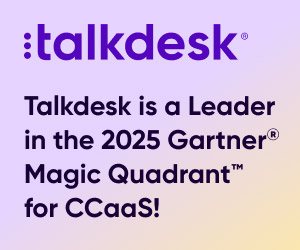
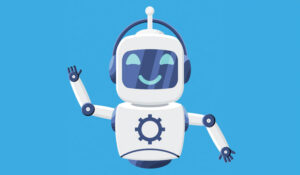
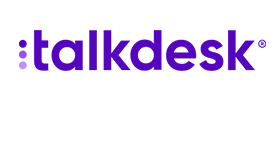 Talkdesk is a global customer experience leader for customer-obsessed companies. Our contact center solution provides a better way for businesses and customers to engage with one another.
Talkdesk is a global customer experience leader for customer-obsessed companies. Our contact center solution provides a better way for businesses and customers to engage with one another. 
